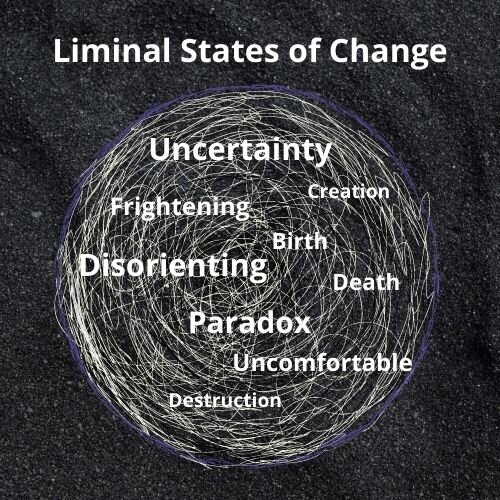Module One
Rite of Passage work is supported empathetically and compassionately as you move through your unique experience of the territory of grief and loss. Imaginal, emotional, and ritual expressions of your journey will deepen and create the pathway to support you each step of the way. Imagination includes the dynamic images of your mind and consciousness that may arrive in waking life or dreams. Emotions are the sensory experiences of your embodied experience in this work. Ritual involves an intentional act or action in the midst of transformation, a death and rebirth process, offered with the intention of making contact with the mythic, divine, or spirit realm. Ritual acts might include a series of actions, incantations, gestures, story, songs, or dance performed in a sacred or designated place.
Supporting Potent Liminal States of Change
The liminal or in-between states of change and transition are places of paradox, where seemingly incongruent events or emotions co-exist. The liminal state is characterized by uncertainty, disorientation, and a state or place where discomfort is common. The image of a dark, womb-like environment may be the best analogy for what a liminal state holds in terms of potentiality.
Stepping into the Liminal
Module One
Reading and Reflections
Read from your chosen book, underline and make notes as you read. Perhaps underlining sentences that 1) resonate deeply with you, 2) offer a new concept or idea, or 3) you do not agree with entirely.
Additional Resources:
Revisit the Questionnaires: Adult, Young Adult/Teen, Children
Consider what has been said to you or what you may have said to others after a loss.
Journaling
1) Choose one or more of your annotations to write about and reflect upon in your journal.
2) Reflect and journal: What have others said or done to support your grief? What has been unhelpful? How have those experiences stirred emotions, feelings, or physical responses in you?
3) Keep your journal with you throughout your day. As you notice the patterns of your life or the emerging patterns, make notes about these and anything else that feels emotionally important, including the work we do together in sessions or in these modules. The act of noticing is powerful in the transformative process.
Ritual Action: Create an Altar or INTENTIONAL Space
Pick a particular location inside your home or outside near your home where you can easily spend time uninterrupted. Make a commitment to do your Rite of Passage work in this particular space most of the time. It is not necessary to always be in this exact location, so please be compassionate and flexible with yourself as you do this work. However, the time you spend in a particular space will create a ritual space for doing this work. You may want to talk to the other members of your household about the space you choose so that there is an understanding. You may include whatever precious items you would like in this space (stones, candle, or other meaningful objects). The arrangement of this space or altar is not stagnant, and is meant to change through your process. You may decide to add items to your altar along the way that reflect the work you are unfolding.
Practices: heartwork, Breathwork, and Sensory Presence
You may close your eyes or leave them open, and take three deep heart breaths pulling your inhale in through the top of your head into your heart. When you breathe in, fill your belly; and when you exhale, allow your belly to collapse. You may do this anytime, anywhere. It is a simple practice that is always with you and has the ability to shift your consciousness and physiology almost immediately. You are encouraged to practice this at least three times daily, more is always better. This breath practice is excellent upon waking and before sleep.
Particularly in the early state of intense loss, anxiety can take us from ourselves and the present moment. The heart meditation is another short practice to bring you back to yourself. Sensory Presence is a practice will support you in finding deep presence.
As you build new practices into your life, you may want to put a little reminder in a place you visit daily (bathroom mirror, car, refrigerator) to ensure you can easily incorporate new practices into your day.
I have provided short audio recordings of these practices.



